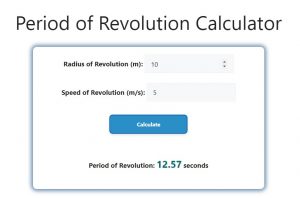About Period of Revolution Calculator (Formula)
The period of revolution refers to the time an object takes to complete one full orbit or cycle around a point. This concept is crucial in fields such as astronomy, physics, and engineering to understand the motion of planets, satellites, and other rotating objects. The Period of Revolution Calculator helps you determine this period based on the object’s radius and velocity. In this article, we’ll explain the formula for calculating the period of revolution, how to use the calculator, and answer some frequently asked questions.
Formula:
The formula for calculating the period of revolution is: Period of Revolution (T) = 2π × Radius (R) / Velocity (V)
How to Use:
- Enter Radius (R): Input the radius of the object’s circular path in appropriate units (e.g., meters).
- Enter Velocity (V): Input the velocity at which the object is traveling along the circular path.
- Click Calculate: The calculator will use the formula to determine the period of revolution.
- View Result: The result will display the time taken for one complete revolution, typically in seconds.
Example:
Let’s say you have an object moving in a circular path with a radius of 10 meters at a velocity of 5 meters per second:
- Radius (R): 10 meters
- Velocity (V): 5 m/s
Using the formula:
- Period of Revolution (T) = (2 × π × 10) / 5
- Period of Revolution (T) = (62.83) / 5
- Period of Revolution (T) = 12.57 seconds
So, the object takes approximately 12.57 seconds to complete one full revolution.

FAQs:
- What is the period of revolution?
- The period of revolution is the time an object takes to complete one full orbit or cycle around a point.
- Why is calculating the period of revolution important?
- It’s crucial for understanding the dynamics of rotating systems, such as planetary motion, satellite orbits, and mechanical systems.
- What units are used for the period of revolution?
- The period of revolution is typically expressed in seconds (s), but it can also be in minutes, hours, or other time units depending on the context.
- Can this calculator be used for non-circular paths?
- No, this calculator is designed specifically for objects in circular motion.
- What happens to the period if the velocity increases?
- If the velocity increases, the period of revolution decreases, meaning the object completes the orbit faster.
- Is this formula applicable to elliptical orbits?
- This formula is specifically for circular orbits. Elliptical orbits require a different approach, considering the varying radius and velocity.
- What is the relationship between the period of revolution and frequency?
- Frequency is the inverse of the period of revolution. It represents the number of revolutions per unit time.
- Can the period of revolution be negative?
- No, the period of revolution is always a positive value, as time cannot be negative.
- Does the mass of the object affect the period of revolution?
- In uniform circular motion, the mass does not directly affect the period if only radius and velocity are considered.
- What is the significance of 2π in the formula?
- The factor 2π represents the complete circular path (360 degrees or one full circle) that the object travels during one revolution.
- Can this calculator be used for celestial objects?
- Yes, it can be used to calculate the period of revolution of planets, moons, and satellites, given their orbital radius and velocity.
- What if the velocity is zero?
- If the velocity is zero, the period becomes undefined because the object is not in motion and cannot complete a revolution.
- How does the radius affect the period of revolution?
- A larger radius results in a longer period of revolution if the velocity remains constant, as the object has a greater distance to travel.
- Is this calculator useful in mechanical engineering?
- Yes, it is useful in mechanical systems involving gears, pulleys, and rotating machinery to understand their rotational dynamics.
- Can I use this formula to calculate the period of revolution for different planets?
- Yes, as long as you have the orbital radius and velocity of the planet, you can use this formula to find its period of revolution.
- How does gravitational force relate to the period of revolution?
- Gravitational force affects the velocity of an orbiting object, which in turn influences the period of revolution.
- Can the period of revolution be calculated for non-uniform circular motion?
- This formula applies to uniform circular motion where velocity is constant. Non-uniform motion requires more complex calculations.
- What is the period of revolution in terms of angular velocity?
- The period of revolution can also be expressed as T = 2π / angular velocity (ω).
- Is this calculator applicable to electrons in atomic orbits?
- While the concept is similar, electrons in atomic orbits follow quantum mechanical principles, so this classical formula may not directly apply.
- Can this calculator help in determining the rotational speed of a wheel?
- Yes, by using the radius of the wheel and its velocity, you can determine how long it takes for the wheel to complete one full rotation.
Conclusion:
The Period of Revolution Calculator is a valuable tool for understanding the motion of objects in circular paths. By using the formula that divides the circumference of the path by the velocity, you can easily determine how long an object takes to complete one full revolution. Whether you’re studying planetary motion, working on engineering projects, or exploring the mechanics of rotating systems, this calculator can provide quick and accurate insights into rotational dynamics.